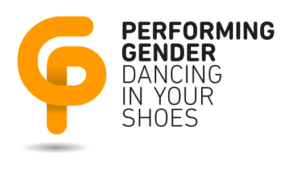City of Women tales: representative objects
The community dance practices of City of Women is a 6-month research and educational process in the field of modern performance arts, with emphasis on modern dance, performance, author’s theatre, and urban intervention.
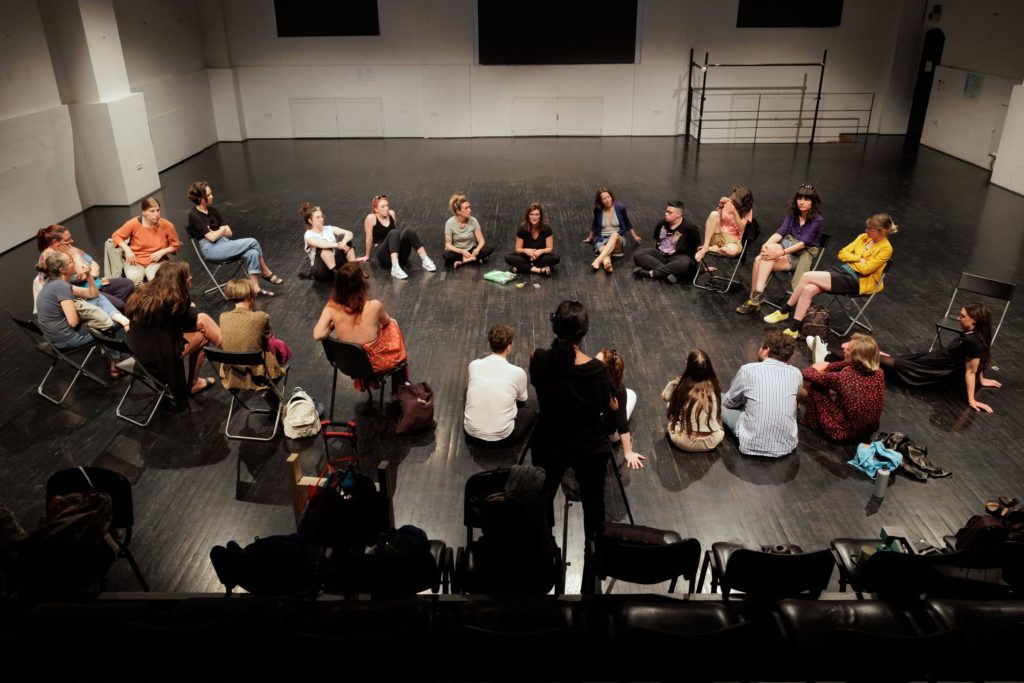
Our initial desire was to invite a diverse group of young participants, with no prior knowledge required but with diverse experience related to specific issues (gender, gender identity and sexual orientation, sexuality) or interest in learning about modern dance and performance. In the end, we created an intergenerational community (17–50 years).
We focused on examining topics related to issues of gender, gender and identity expression, and societal norms, through a mixture of practical and theoretical approaches. We were also interested in the relationship between individual and collective design and execution of the various phases in the creative process, from looking at the issues and developing concepts to the performance itself.
To encourage artistic expression and develop material we used different techniques — improvisation, somaesthetics, hypnosis, flash composition, idea embodiment, participant observation, and writing. Throughout, we learned about the artistic practices and creative processes of selected artists from the second half of the 20th century and the turn of the 21st century, such as Lygia Clark, La Ribot, Yoko Ono, Catherine Contour, Meg Stuart, etc.
Our last rehearsal at the end of the module was designed as an open rehearsal which welcomed the immediate community of the City of Women.
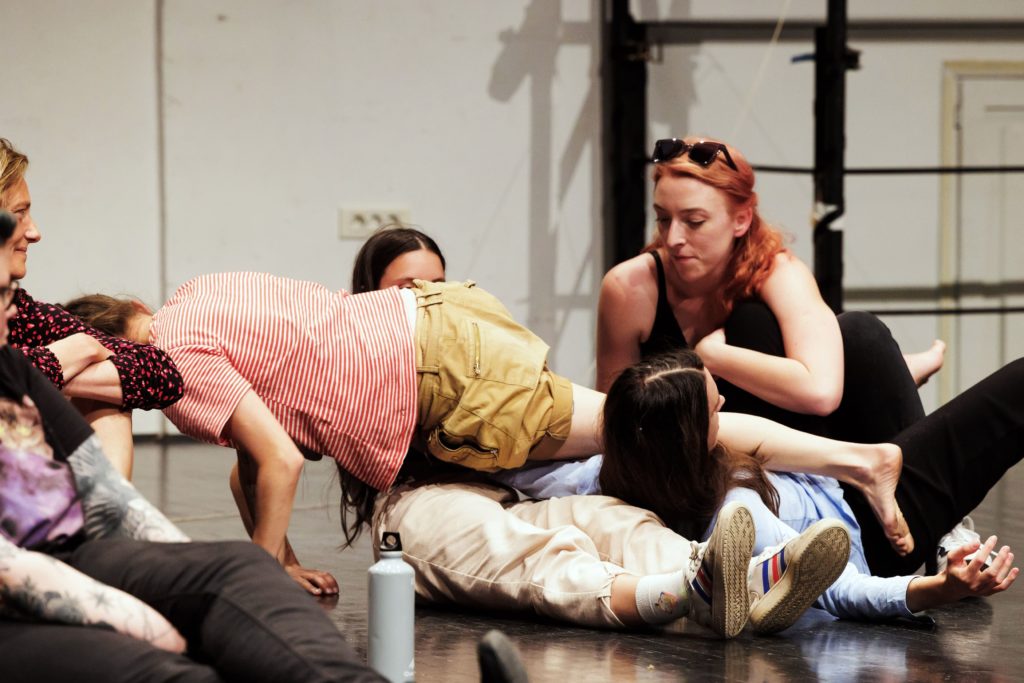
OPEN REHEARSAL — Meeting the local feminist art community
At the open rehearsal, the groups presented several drafts trying to answer the question:
Which object do you connect with performing gender?
Based on the selected object, the participants developed individual actions which were further enhanced with group interpretation or collective conclusions of scenes. These actions included hanging out the washing; cutting wood; drawing symbols on the body; using pink and blue towels; using dildos and shawls.
The first action took place in a toilet, the last one in the lobby, whereas all the others developed within the space of a stage. Some of them were representational, while others presupposed active audience involvement.
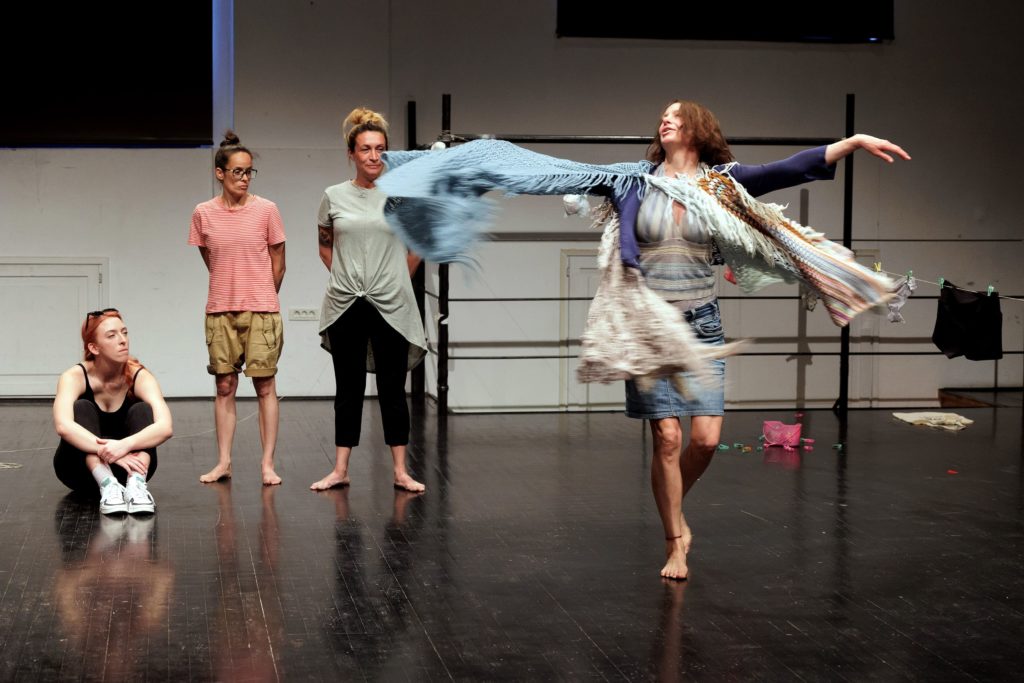
Colour pencil
(concept: Petja Horvat Sonda; performance: Alja Lacković)
The scene was staged next to a mirror in the women’s toilet. In Stara mestna elektrarna, there are two toilets, women’s and men’s — they are labelled by door stickers. Thus problematises the context in which it takes place.
The performer uses body painting and various gendered symbols (penis, vagina, moustache, tear, necklace, tie, a tattoo of an anchor, six-pack, the word baby written across the stomach, etc.) to mark her body; significators cover the surface of her skin, layering, transforming and complementing each other so that they eventually create a multigender body.
Even the act of “masturbating” in the corner, which concludes with the performer turning towards the audience, her hands white, has a transformational effect since the performer merely ends up conditioning her body by applying lotion with her hands.
While doing so, she enters the private sphere, unambiguously and emphatically, by uttering the only verbal statement of the performance, Could I have some privacy, please? It is only at this point that the public becomes aware of its voyeurism so that the scene reflects the spectator’s position on yet another level: who is watching whom?
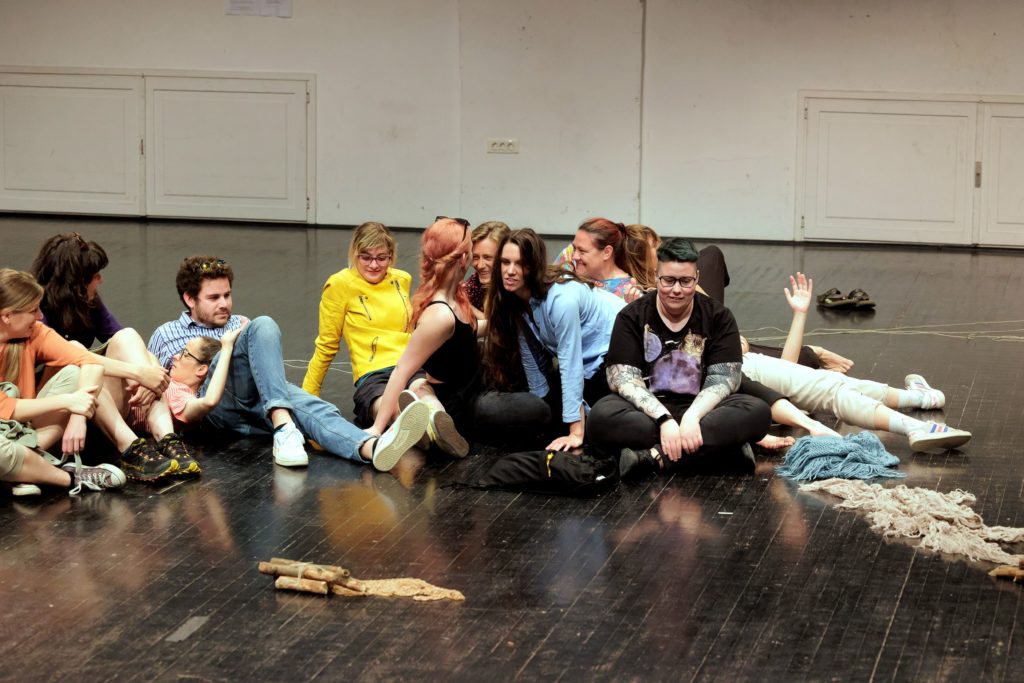
Transience
(concept and performance: Ankica Radivojević)
In this scene, a woman is hanging out the washing, beginning with a diaper and then progressing to children’s underpants. We expect the performer to continue the series by hanging increasingly bigger underwear but despite finishing the hanging with an incontinence diaper, she breaks away from the expected narrative.
Despite the connecting thread or motif — the transience of human life — illustrated with the thread of life, in other words, life from one diaper to another, the scene unfurls into several layers once the performer starts moving the various pieces of underwear from one place to another, highlighting the caretaking aspect (household chores, care of children, grandparents...).
And while trying on diapers comes across as comical (I, baby; should I have a baby?), once the performer tries on girls’ underwear the tone quickly shifts toward darker associations of paedophilia. The scene is then joined by other performers who manipulate the loose remainder of the clothesline and pull it, get entangled in it, are left hanging on it while holding it in their hand, intertwine with each other, etc.
Given the previous significators (underwear, transience, vulnerability, etc.), this entangling with the line suggests the knottiness and complexity of life, human relationships and care, which leaves additional potential for further development of the scene.
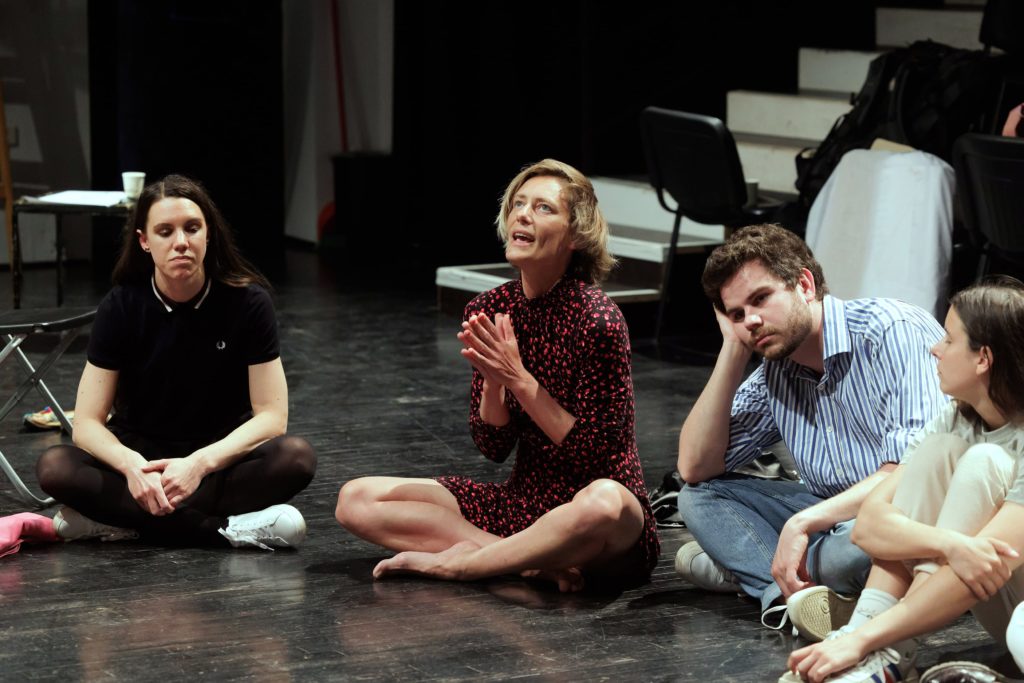
Three saws
(concept and performance: Teja Bitenc)
A personal story of a performer who took to cutting firewood with her saws during the lockdown. The improvised platform for sawing unintentionally complicates the action by making it difficult for the performer to saw; the scene is then further joined by other performers who try to assist her.
The performer’s openness, spontaneity, and interaction with the audience leaves the (mostly female) onlookers with the impression that anyone could do this, despite all the difficulties with the sawing — or precisely because of them.
It is reminiscent of the attempts to empower women in masculinised fields, for instance, the skills workshops promoted to women by the home improvement retailer Bauhaus. Because it remains unclear if the performer can saw enough wood to heat her apartment, there is a danger of the performer’s character and actions accidentally turning into a commentary on themselves.
However, this is also the reason they elicit a series of reactions :“I was bothered by the fact you can’t saw”, “first learn how to use the saw”, etc., which is further enhanced by the petiteness of the performer’s body.
The relationship between the stable and unstable surface, between controlling the action, i.e. the self-assured, fast, and effective sawing, and its counterpoint (incline, slipping, trying to hold your balance) invites us to further examine not only this topic but also other scenographies and corporealities trying to keep up with each other in the process of attempting to control and find balance in impossible situations.
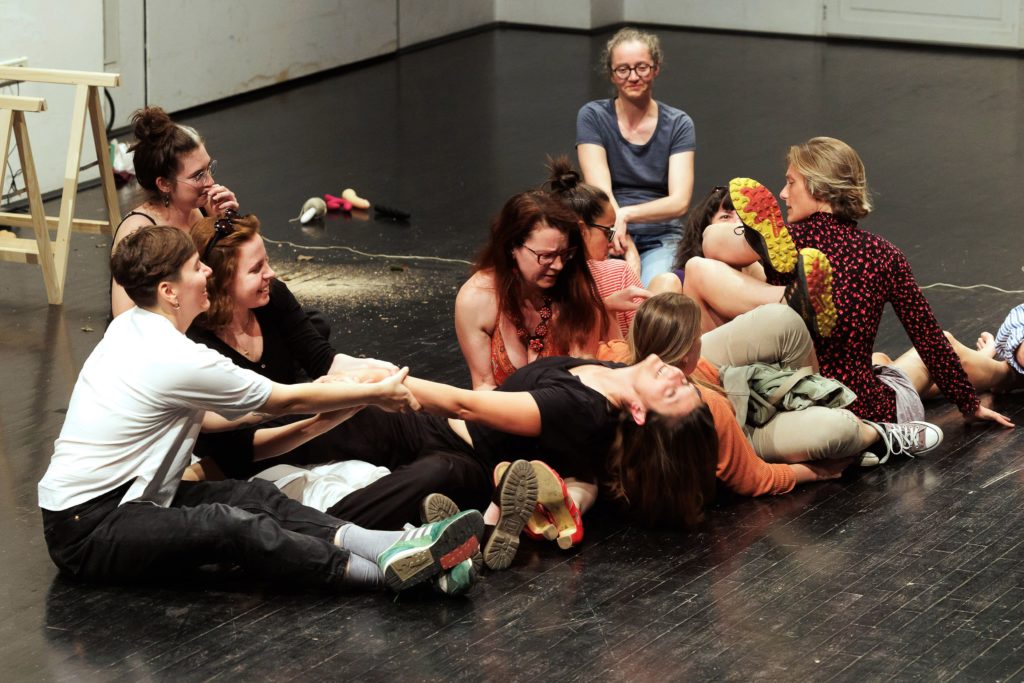
Dildo
(concept and performance: Alja Lacković)
The scene opens with the performer showing great interest in the various packaged objects stacked on the floor in front of her.
As she gradually opens them, the colourful dildos inside them start to move at various vibrations and speeds. The performer is intrigued by their movement and sound — as one of them moves away because of the vibrations, she moves it closer to her as if she was moving closer a baby trying to explore its environment.
Following this opening, which stresses the implied relationship between the performer and her dildos, she suddenly moves into a corner, visibly irritated; while hastily putting away dildos into a box that is too small for them.
She breaks into a monologue about this scene being something entirely different from what she had imagined. She is unhappy that the other performers failed to join her (potentially sexual?) game and frustrated because she had wanted them to also try her dildos and everything else they are capable of beyond being a means of sexual play and joy.
The scene compels us to reflect on how theatre is a machine for creating states, emotions, and desires, and how we can use these to build a scene. In doing so, how can we escalate this incapacity to bring forth pleasure? This is particularly interesting in relation to the object itself, i.e. the object of desire, be it a dildo or a co-performer blocked from having the freedom to engage with the object of desire.
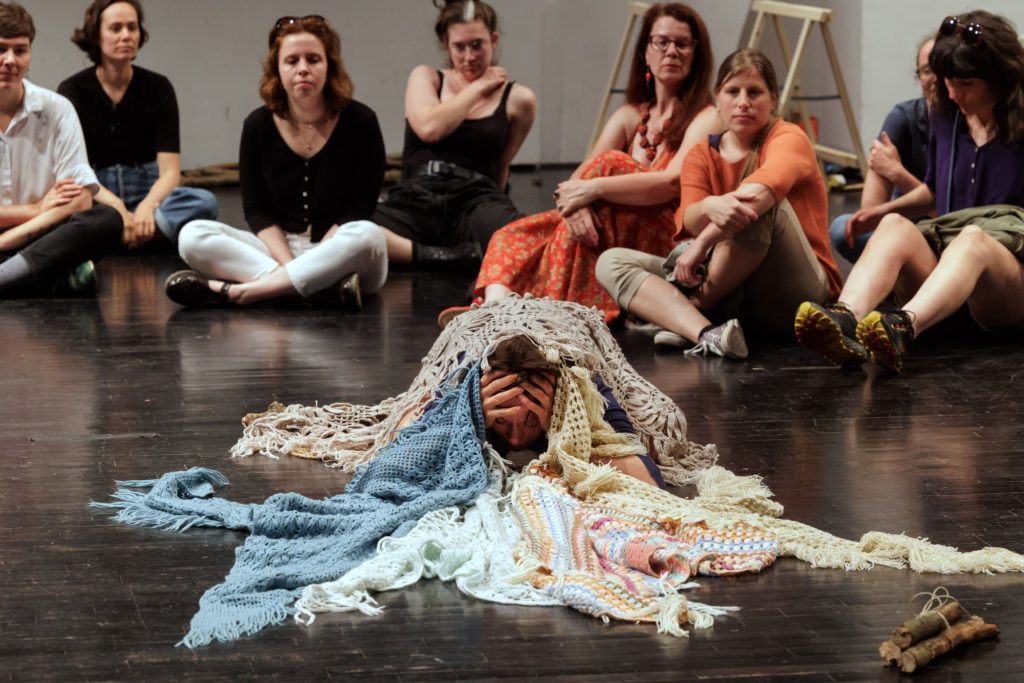
Interwoven
(concept and performance: Martina Štirn)
In the opening part, a performer dances with two interwoven shawls; this entwining then shifts onto two performers who keep covering each other with shawls, as if they were blankets.
She is joined by another performer who tries to entangle her, seduce her, and take her away; the intertwining of their bodies is punctuated with soft words, whispers, and laughter; they are accompanied by another couple of interlaced performers.
Both couples approach the mass of audience bodies and roll and swirl through it, touch it, and exchange sweet whispers with it (“you smell nice”, “what perfume do you use?”, “your skin is so soft”, “I like your tight-fitting jacket”, etc.). The scene transforms from a failed attempt at togetherness (it takes two to form a couple) into a collective coming together of many bodies — it is reminiscent of 1960s happenings which broke taboos about the collectivisation of pleasure, nakedness, and touching between strangers.
In the post-pandemic context, it also comes across as a simple cry for togetherness.
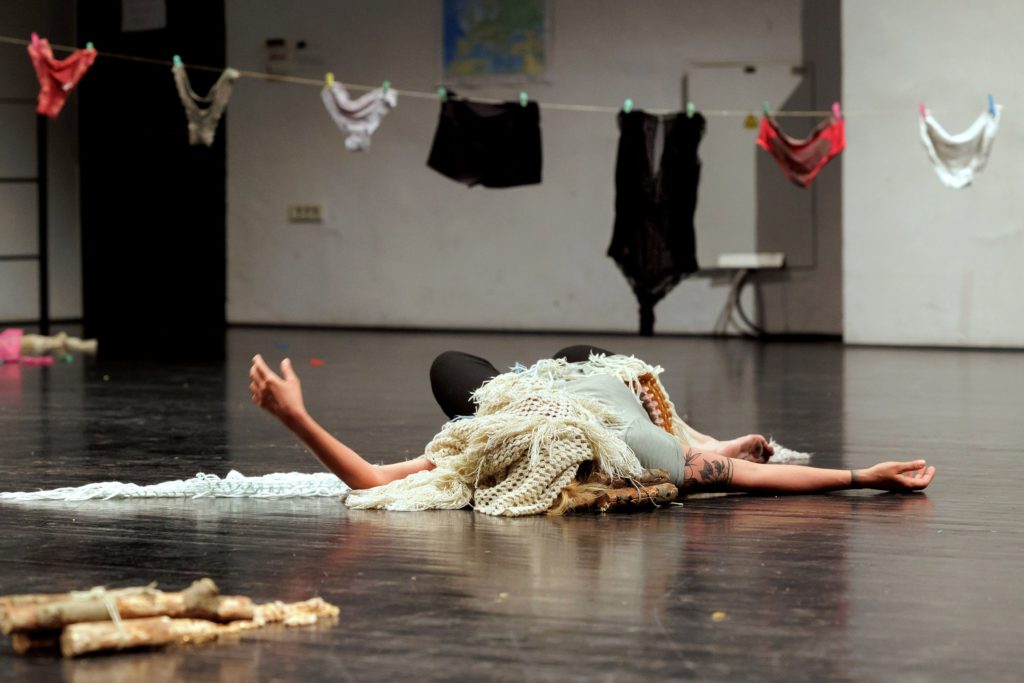
Towels
(concept: Špela Čekada; performance: Alja Lacković)
A dancer whose body is obscured by a blue and pink towel gradually and slowly reveals specific body parts, conveying recognisably stereotypical images of women and men (a naked back turned against the public revealing muscles and tension; a swan leg protruding from the towel, etc.). She further transforms her image by changing the towels into a mini skirt, a nun’s habit, and an evening gown; other times she simply drapes the towels around her shoulders.
The play on stereotypical images which characterise our (visual) culture, spanning commercials, advertising, painting and fashion, is additionally highlighted by the choice of pink and blue towels as culturally determined, gendered colours.
It would be interesting to examine the potential of the scene for playing with binarity in multiple directions, so that colour would no longer necessitate a specific image nor would typified movement necessarily imply a specific gender representation. The scene could also achieve its aim by placing variously identifying bodies behind the towels.
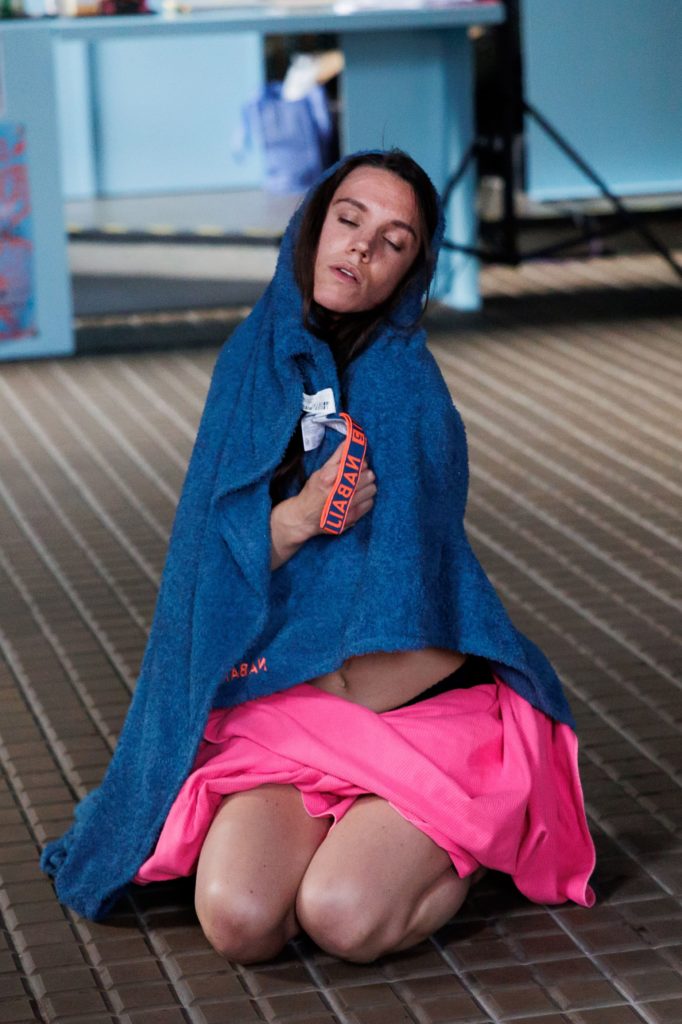
Feedback and thoughts of the local community
PG DIYS, which is trying to address and include the relevant target groups, it seems fundamental that the processes are designed to include diverse and specific target publics at regular open rehearsals; their responses are key for understanding social differences and their effect on the perception of an art event or process.
In terms of the general response, the most striking observation was a question about which gender gets to be performed and which does not. If you chose to bring something to light, then, by necessity, something else remains obscured.
Another feedback highlighted the question of perspective — the identity of the viewer defines their manner of seeing and “reading” scenes and symbols.
At the same time, such a response provides the opportunity to enhance the sensitivity of everyone included and offers tools for improvement, research, and creation of representative and participatory starting points. Further emphasis was put on placement (context/space) and open form as a mode in which the relationship between the performer and the audience needs to be continually re-established. Our attention was also brought to the relationship between performing in both performative and private sense:
How do we transit from one space to another and how do we delineate the difference between public and private body?
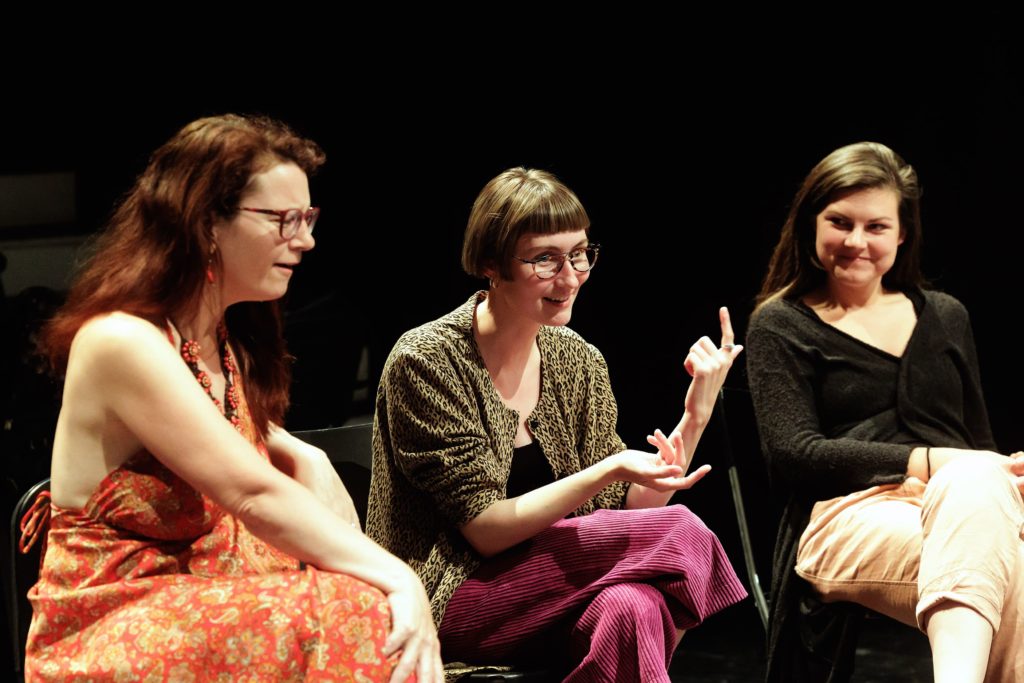
At the end of the first part of the process, the participants expressed the desire to continue their work in the upcoming workshops in a way that would enable them to gain experience and tools for working with target groups; they also wanted to be responsible for the final community dance production at the end of the project.
The Performing Gender journey is only just beginning and a lot of news is coming. Keep following us on our Facebook page!

